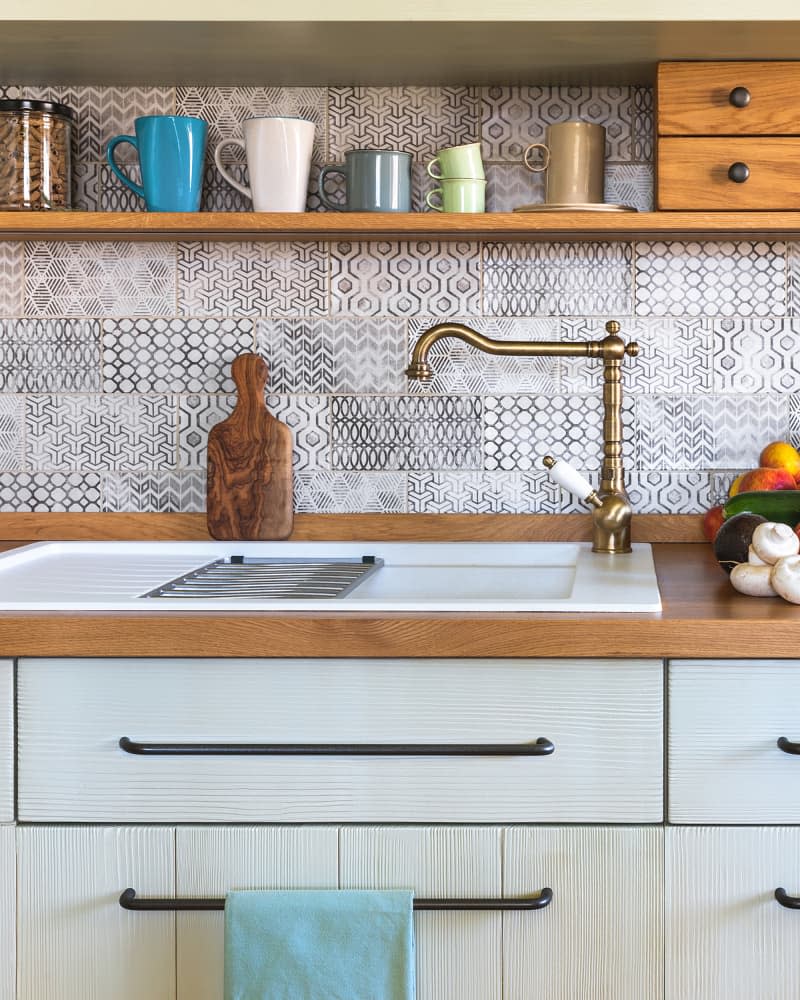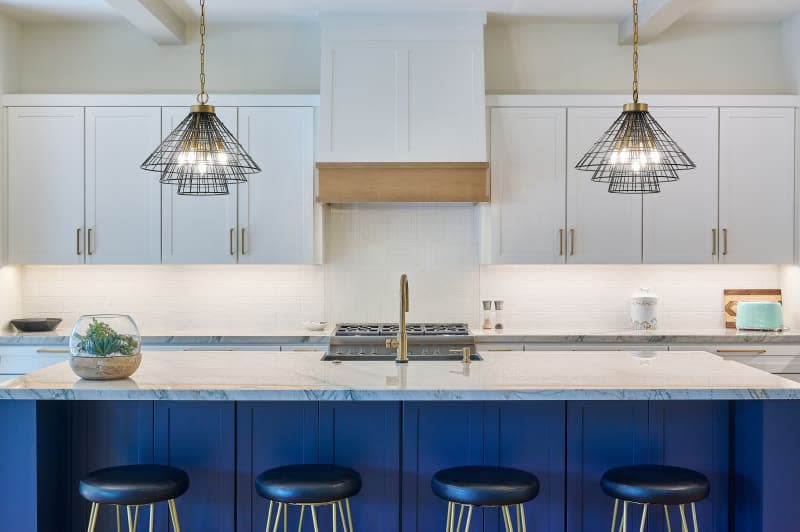14 Kitchen Design Trends You’re Going to See Everywhere in 2024
No matter how cozy the couch or how large the dining table, the kitchen is indisputably the heart of the home — family and friends are always drawn in for drinks, conversation, or cooking together. With more people working from home than ever and a renewed focus on customizing our spaces, homebodies everywhere want more from their kitchens. And rightfully so!
So, what’s next in kitchen design trends for 2024? To find out, we reached out to some of our favorite interior designers and pulled data from the National Kitchen and Bath Association’s annual kitchen trend report (which surveyed a wide range of industry professionals from contractors to architects). From innovative cooktops and storage systems to trending counter materials, here are the 14 kitchen trends to look out for in 2024.
1. All Green Everything
If you’ve been dying to emulate Dakota Johnson’s green kitchen but haven’t yet made the leap, you’re in luck — shades of green aren’t going anywhere. “Green is still going strong in design in general, from walls to cabinets to tile,” says Vicky Serany, co-founder of Southern Studio. “I have traveled to Spain, Portugal, and Italy to the design and tile shows this year and it’s shown in every collection as part of the color palette, which tells me it’s here to stay for a while.”
2. Stained Wood Cabinets
Rest in peace, all-white kitchens … you were impossible to keep clean, difficult to personalize, and just no longer inspire! But wood tones are back, baby. “I’m seeing the return of stained wood cabinets as opposed to painted cabinets,” says Shamika Lynch of Maximizing Tiny. “Whether it’s in an appliance garage, pantry, or all the cabinets, homeowners are growing tired of the maintenance that comes with painted cabinets. Although they’re often less expensive than ‘stain grade’ wood cabinets, they don’t patina as well, and as a society we’re finding our way back to prioritizing sustainability.”
“Natural wood is a must in the kitchen to give warmth,” adds Jeanne Chung, principal at Cozy?Stylish?Chic. “Our clientele no longer wants a sterile kitchen — they want a kitchen with life that feels lived in. White oak and walnut have been at the top of the list in terms of trending wood species, and we’re also starting to use alder, as it stains nicely, has a nice grain pattern, and it does well in both modern and traditional settings. In addition, we’ve also incorporated wood beams above and water-resistant wood floors. People are spending more time at home so they want their homes to feel intimate and cozy.”

3. Sinks That Work Harder
Considering that doing the dishes takes nearly the same amount of time as actually making the meal, sinks could stand to work a little harder than they already do. That’s where workstation sinks come in. “A workstation sink has separate stations for washing fruits and vegetables, cutting and chopping, and washing and drying dishes,” explains Eva Higby of Higby Design. “This creates more space to prep fruits and vegetables in the sink, and I love that it reduces the mess and creates more workspace.”
4. Induction Cooktops
The last major innovation in stovetops happened in the early 1900s with the advent of electricity, so we’ve certainly been due for a new method for some time now. Plus, with new environmental regulations regarding gas cooking, more people than ever are looking to invest in a long-term reliable cooktop. “Induction cooking is getting smarter and sleeker; the cooktops are easily integrated into the countertop for a cleaner surface,” says Higby. “I have even seen induction cooktops that are hidden below the countertop so when they are off, you’d never know it was there. They heat fast and cool quickly, so are great for families with young kids. They are also quite precise, allowing for a range of temperatures from boiling to warming.”

5. Pull-Out Appliances
Who says the fridge needs to be one hulking appliance, and not a few different focused drawers spaced throughout the kitchen? Higby notes that fridge drawers are trendier than ever, as a place to keep waters, seltzers, and sodas, and anything else a family might want to grab and go. “Dishwasher drawers are showing up more and more as well,” she says. “Two dishwasher drawers can replace the standard dishwasher, but many times they are being added in addition to standard dishwashers to areas like beverage stations and home bars. They are ideal for smaller loads and quick washes.” These appliance drawers are also easy to integrate into cabinetry with matching panels so they blend right into the background.
6. Drawers in Lieu of Lower Cabinets
If the upper cabinets have gone in favor of shelving, this means the lower cabinets need to pick up the slack. But oftentimes they’re difficult to organize and a pain to reach into. Higby remarks that they’re being replaced by drawers altogether, because it’s “so much easier to open a drawer and pull out your plates or your pots and pans. Once my clients discover how easy lower drawers are, they want to put them into every bathroom as well!” In addition, tall, full-height cabinets are a great option for pantries as well as storage space for appliances like mixers, toasters, and coffee makers.
7. Minimal Backsplashes
More cooking at home means more cleaning the kitchen, and Higby has found that this has led to a more minimal approach when it comes to backsplashes. “People hate cleaning grout lines and love the look of continuing the countertop material up the backsplash,” she says.” By continuing the countertop material onto the backsplash, you create a clean and crisp feel and can show off that beautiful material!”
8. Slab-Front Cabinets
“While shaker-style cabinets were the go-to over the past decade, we are designing kitchens with more slab fronts,” Higby says. “I love the clean look of the drawers and doors. It supports the ‘less is more’ trend in kitchens. They are also a breeze to clean!”

9. A Move Away from Marble
Surely your social media feeds have been chock-full of kitchens bedecked in intricate, veined marble for some time now, but one thing people are realizing? Marble is a lot of work to maintain. It is certainly beautiful and, with the right care, can last forever, but not everyone wants to put so much work into their kitchen countertops. “Most of my clients are busy families and don’t have the patience for marble,” agrees Higby, and instead recommends Quartzite. “It’s a natural stone like marble so it has beautiful and natural veining that comes in many variations,” she says. “While marble is known for being soft, quartzite is hard and durable like granite. Quartzite is porous like any natural stone, but once it’s sealed it’s good to go for heavy use. Quartzites are beautiful, and a honed or leathered finish makes it easy to keep clean.”
Another countertop material getting its day in the sun is sintered stone, such as Neolith or Dekton. “I definitely see the industry moving more into Dekton countertops,” Lynch points out, because “they’re a lot more durable, easy to clean, and come in a wide array of options.” That said, if you’re still set on marble (we get it), Wahler notes that there are new products that act as protective shields for marble that the stone yard vendors she works with are getting excited about.
10. Smart Ovens
You heard it here first: The microwave is out and the smart oven is in. “Speed ovens, air fryers, and new light-based cooking are replacing microwaves because appliances need to be more than fast — they need to be smart,” Higby says. “Smart ovens are not only fast, but they also improve the cooking experience. They often come with built-in recipes and even connect with your phone.” Higby is personally enamored of the Brava, which uses light-based cooking to cook more efficiently, and is connected to an app that walks you through recipes and allows you to watch something cook from another room.
11. More Functional Islands
It’s no surprise that people want more from their kitchen islands than just being an extra prep space — it needs to also serve other functions. “If the kitchen is the heart of the home, the island is the heart of the kitchen,” Higby says, and because it’s so essential, she finds her clients placing more priority on it than they used to. There’s been an increase in incorporating workstation sinks, adding smarter storage, and getting bigger to accommodate more seating. Sarah Robertson, principal designer at Studio Dearborn, has seen the island trending away from “all in a row” island seating and instead towards wrap-around seating, and Higby adds that she just recently completed a 12-foot island with seating on both sides, which takes the place of a separate kitchen table.
12. Built-in and Hidden Kitchen Tools
Could open concepts and floating shelves really be gone for good? Maybe not, but Olivia Wahler of Hearth Homes Interiors has definitely noticed a shift back towards closed storage. “Appliance garages (our personal favorite) have been on the rise,” she says. “As well as hidden drawers, integrated step stools, charging drawers, hidden pet food storage and feeding stations, and the sneaky toe-kick storage! Our clients have been leaning heavily into the idea of as much functional storage as possible, leaving no room for wasted space.”
13. Dedicated Beverage Stations
Whether it’s a bar for entertaining, a nook for coffee and tea, or even a kids’ drink fridge, almost all the designers we spoke to mentioned an increase in requests for beverage stations. “It seems that the pandemic shifted the way people use their kitchen and created a new era of homebodies,” Wahler says. “Our clients aren’t going out quite as much for cocktails or coffees, and instead have put an emphasis on wanting to have a place to both prepare and enjoy these types of things at home.” Elizabeth Valentina, CEO of Nar Design Group, agrees, adding, “Beverage centers are rising to the top of desired items to include in a kitchen, now including coffee and tea service, water dispensers, under-counter refrigeration, and frozen goods storage for smoothies, shakes, and acai bowls.
14. Layered Lighting
Kitchens shouldn’t be excluded in the pursuit of warm, cozy lighting. While bright daylight bulbs are often chosen for task lighting, you can still layer in other styles and fixtures. “Lighting is more important than ever in a kitchen, and many layers are used to achieve the best result,” Seranay says. Robertson adds that her firm loves to use “pendants over the island and sconces over windows or flanking the range, and are moving towards small flush mounts instead of recessed lighting. If we have a large open counter space, we introduce a table lamp.” What’s more, Valentina says, “Lighting cabinet interiors creates an enhanced experience, allowing for better engagement with the internal cavity of the cabinet or space.”
